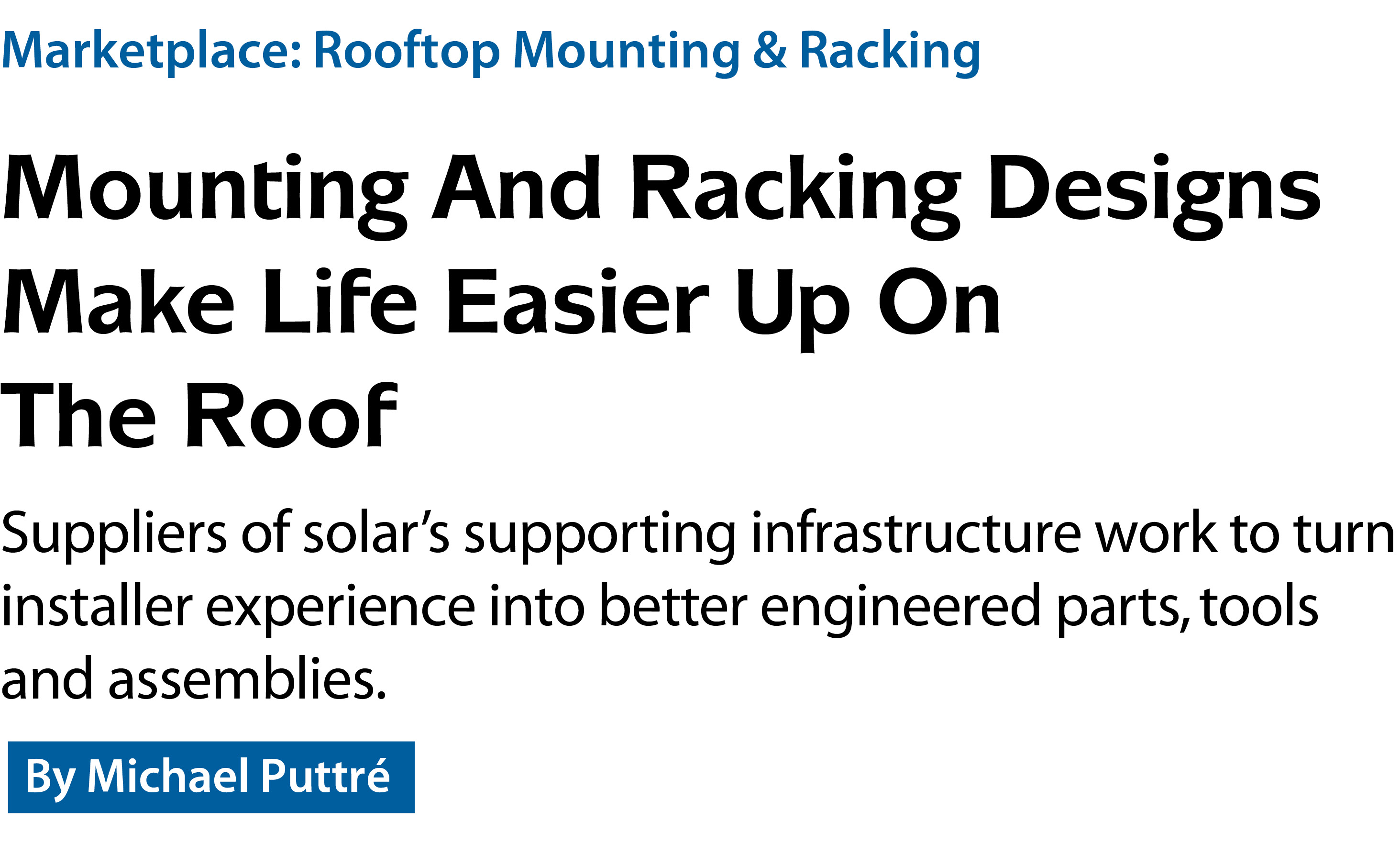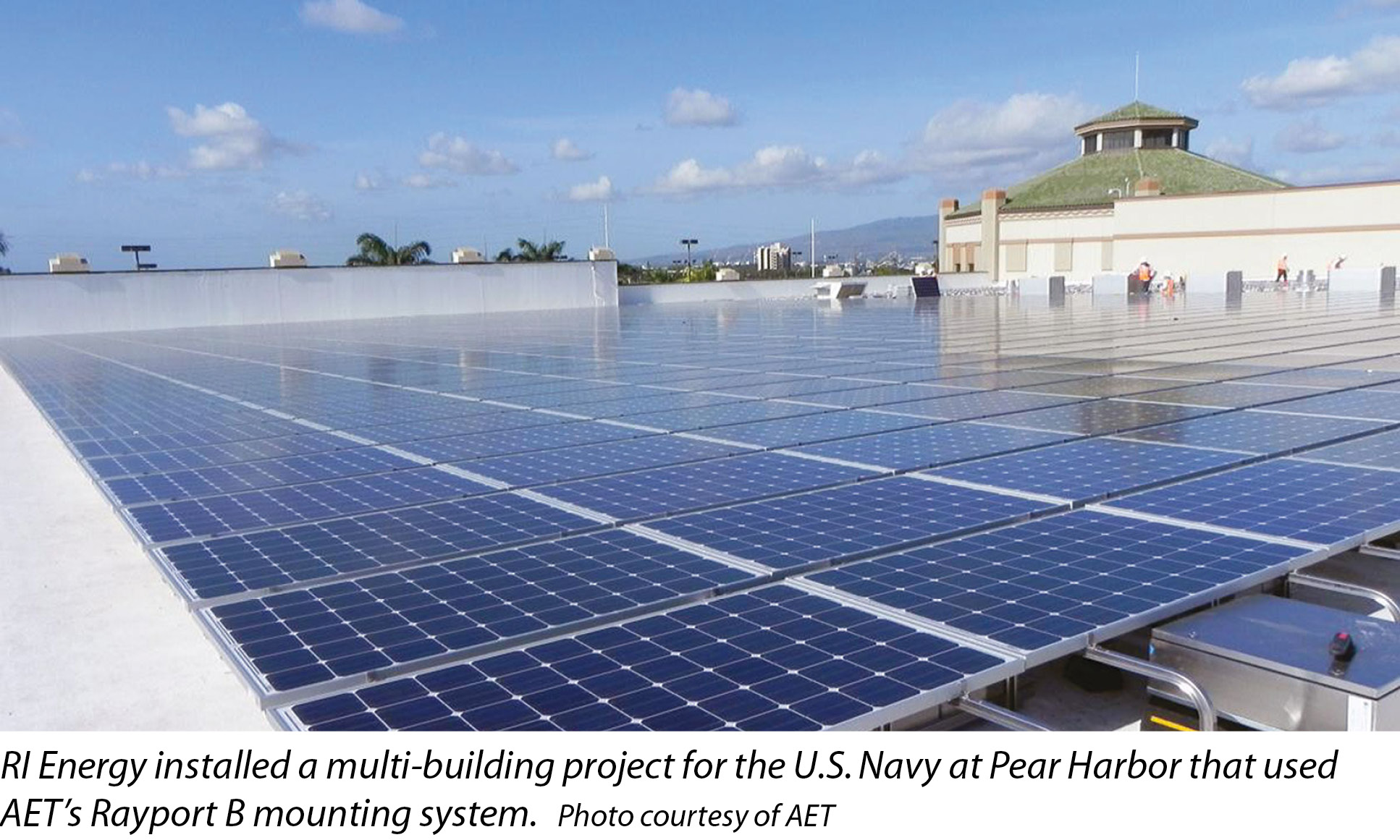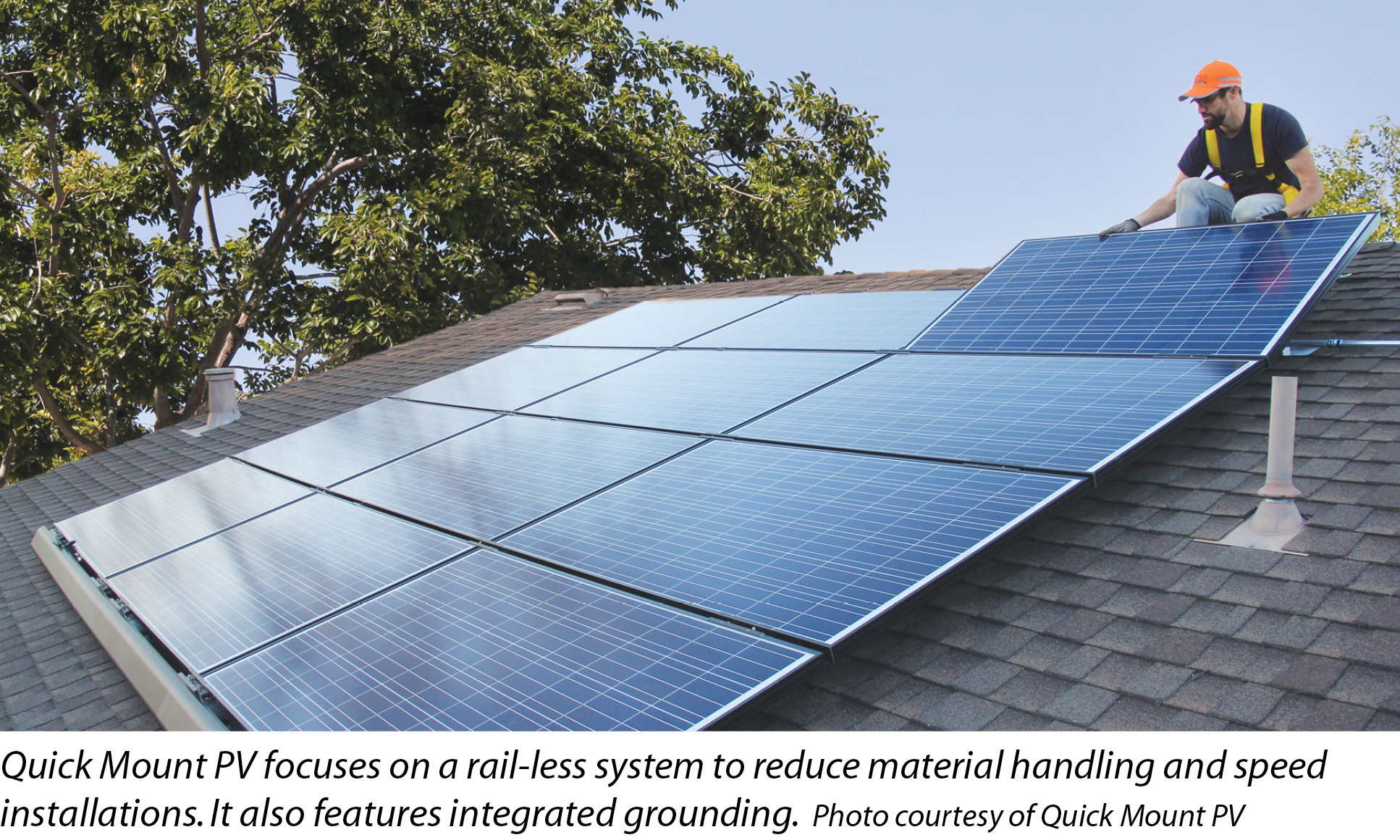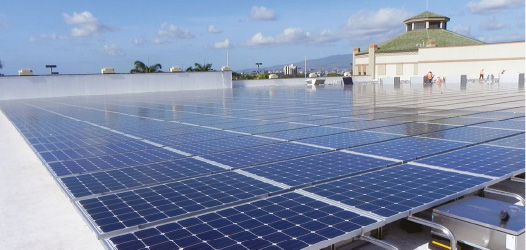

301 Moved Permanently
The effort to reduce the cost of deploying solar photovoltaic power has for a decade focused primarily - and rightly - on the panels themselves. While engineering and research and development have played roles in this effort, the battle was essentially one of scale and manufacturing.
At the same time, manufacturers of the supporting infrastructure have been engaged in an ongoing effort to design and produce mounting and racking systems for these solar panels in a cost-effective way. One racking manufacturer says his company is in “generation 16.0” of its product line, the result of an ongoing process of engineering in response to customer feedback.
As the solar sector looks beyond the PV panel for opportunities to reduce costs, racking and mounting system manufacturers are stepping up to deliver those cost savings. In particular, developers of rooftop racking and mounting systems have gone to great lengths to refine their products for the space and time constraints of roof-mounted PV systems.
Aaron Faust, co-founder Applied Energy Technologies (AET), says the key to success in the modern mounting and racking market lies in refining engineering processes: designing systems that meet a high standard without being over-designed.
“It has always been easier for racking companies to over-design than optimize their products,” Faust says. “We are seeing more designs centered around cost optimization in order to meet the demands of cost-conscious [engineering, procurement and construction] firms. The top-selling products on the market have been cleverly designed to reduce installed costs. They no longer have excess features, and they have been manufactured using carefully selected materials.”
According to Faust, cost-cutting measures have also been driven by the installation portion of the process. “Racking companies are working not only to lower the price of their products but to reduce labor costs for customers by making installation easier,” he says.
Faust cites a December 2013 study by the Rocky Mountain Institute and Georgia Tech Research Institute that compared U.S. and German racking and mounting installed costs, which were $0.16/W and $0.04/W, respectively. The study identified non-value-added activities as opportunities for cost reduction and concluded that U.S. installers could reduce installation labor costs by 64% if they removed such activity from the process.
“We view price pressure as a positive for racking companies and for the industry as a whole,” Faust says. “It provides an opportunity to diversify - perhaps to compete on products and services rather than just being a component manufacturer - and an opportunity to innovate, putting R&D dollars into improved materials and designs.”

Faster, please
According to Jack West, president and chief technology officer of Zep Solar, his company’s launch of a racking and mounting system product for flat commercial rooftops last year came after an R&D process that included installation speed as a main objective.
“We took a very holistic approach, from looking at how PV modules are made, shipped and get up on roofs to how they get mounted and how installers bring wire down off the roof,” West says. “We really tried to take a full-system view and tried to figure out how to make that whole system more efficient.”
From a product development standpoint, West says Zep has been exploring the possibilities of launching a commercial rooftop product for about three years. The efforts were focused on porting over applicable features from the company’s residential products while making design changes appropriate for flat commercial roofs. The goal was to field a product that was suitable for the commercial space while enabling features that save on installation time.
It turned out that a lot of the features that West says have proven successful in residential installations also looked like they would work well on commercial projects, too. Perhaps the signature feature of Zep racking and mounting products is a requirement for the use of Zep-compatible modules.
“The idea of the groove-frame modules that really forms the basis of our residential product carries through,” West says. “The Zep-compatible modules allow us to do some really cool stuff, like snap-together mounting and automatic grounding. A lot of the benefits that really drive labor costs out of the system come through prepackaging with grooves and received wire clips.”
West describes the commercial racking system as essentially a system of tubes - essentially conduits. These form the structure of the mounting system. It’s designed to be tool-free, with the tubes snapping together like a beach umbrella, with a little button that goes into a little hole. The solar panels then snap onto that. There’s a receiver on the tube structure that snaps into the Zep groove on the panels.
“We’re pretty comfortable saying that it is a two-times savings on installation speed,” West says.
Of course, not every racking and mounting manufacturer has the sort of market clout to get module manufacturers to produce specialized designs for their products. The fact that Zep does have that sort of clout was one of the drivers behind SolarCity’s acquisition of the company in 2013.
“Most of the major manufacturers make Zep-compatible modules now,” West says. “If you want to sell to SolarCity, you want to make the modules that SolarCity wants to buy.”
The flip-side of this is that SolarCity’s acquisition of Zep essentially takes its racking and mounting systems off the market for everybody else. Other players, such as Campbell, Calif.-based Spice Solar, have stepped in to fill the void. Spice Solar has developed its own series of racking and mounting systems that make use of a certified compatible module design and licensing structure. Spice Solar says compatible modules and components connect and ground all modules in both portrait and landscape orientations.
In addition to its module certification program, Spice Solar has also worked to develop racking and mounting systems for flat and sloped roofs with other features to improve installation time. For example, the company’s Built-In Racking system consolidates the number of parts installers require by as much as 50%, reducing inventory and labor costs.
A number of manufacturers invest in engineering to integrate parts to achieve the same effect. California-based Quick Mount PV has developed its Quick Rack rail-free solar mounting system for composition and asphalt shingle roofs. The Quick Rack integrates the roof mount and the racking in order to reduce installation time. The base mount incorporates a pre-assembled top slider that is adjustable. Panel clamps attach the modules to the mounts and also connect the modules together, giving the assembly a structural function. Integrated grounding pins eliminate wiring and require a single grounding lug for the entire array.

Field feedback
Andrew Worden, founder and CEO of New York City-based GameChange Racking, says that while codes and standards have driven many aspects of racking and mounting development, the majority of the company’s engineering efforts are efficiency-driven, so there can be quicker installs.
“Our background building solar power plants before we got into the racking business helped us understand how important it is to not just be able to put in the racks quickly, but to do the wiring before you put the panels on,” Worden says.
With reference to the GC Ballasted Roof System, Worden says the engineering efforts result from first-hand knowledge of how difficult racking and mounting assembly can be if material and product cost is the primary consideration. However, experience demonstrates that the complexity of the assembly process and how time- and labor-consuming it is has redirected the focus on eliminating steps and parts in order to make assembly more efficient.
“One of the things about these disconnected systems is that they are simple,” Worden says. “There are just a few parts. There’s a pan to put the ballast in, and it also holds up the panels and a wind deflector. We figured out a way to make a wind deflector that, first of all, works great so you need less ballast, and second, it functions as a jig.”
For example, for a standard panel that is 77 inches long, GameChange makes the wind deflector a little longer so it provides spacing in the east-west axis for a south-facing array. Installers would otherwise need a jig for that purpose. The assembly also has features and guides for prewiring the array and then placing the panels with a single tool.
“We didn’t have these features in the beginning,” Worden says. “You have to think it through from the installer’s perspective.”
Making a connection
Another avenue of labor- and time-saving installation technology can be found in the tools, fasteners and wire management systems intended to move installations along.
S-5!, a Colorado-based developer of metal roofing attachment systems, produces its S-5-PV Kit, which employs a stainless-steel mounting disk that enables conductivity with anodized aluminum module frames. The design provides module-to-module electrical continuity with the intent of reducing installation costs. Traditionally, this bonding was accomplished by connecting modules with ground lugs and copper wire.
Although no lugs or wires are required from module to module, S-5! says, wires or lugs will still be needed to bond strings together and to ground the system.
Snake Tray, a Bay Shore, N.Y.-based manufacturer of cable management and power distribution products, produces a number of systems for deploying cabling for rooftop PV designed to ensure code compliance while reducing installation time. The Solar Snake Tray is a hand-bendable system for rooftops that carries DC cabling from solar panels to their terminations. Built-in mounting rings enable a variety of mounting options, and multiple trays can be daisy-chained with a single connector at each join.
The challenges of rooftop racking and mounting systems are primarily mechanical in nature. While new materials and part geometries play a role, this facet of the PV project is perhaps the most labor-intensive. Therefore, the engineering required to make more efficient infrastructure comes from understanding how installers work and turning that process knowledge into parts. R
Marketplace: Rooftop Mounting & Racking
Mounting And Racking Designs Make Life Easier Up On The Roof
By Michael Puttré
Suppliers of solar’s supporting infrastructure work to turn installer experience into better engineered parts, tools and assemblies.


si body si body i si body bi si body b
si depbio
- si bullets
si sh
si subhead
pullquote
si first graph
si sh no rule
si last graph